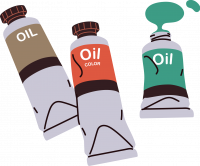Starting your oil painting journey is exciting—but like any new skill, it comes with a learning curve. Many beginners run into the same challenges when they first pick up a brush. The good news? These mistakes are easy to avoid once you know what to look out for. In this article, we’ll break down five common pitfalls and how to overcome them, so you can build a strong foundation from day one.
1. Using Too Much Solvent
One of the most frequent issues is overusing turpentine or mineral spirits. While solvents are helpful for thinning paint and cleaning brushes, using too much can weaken the pigment and leave your artwork looking washed out. A good rule of thumb: start with small amounts and focus on using oil mediums like linseed oil when possible.
2. Ignoring the “Fat Over Lean” Rule
This classic rule means that each layer of paint should have more oil than the one beneath it. If you apply lean (less oily) layers on top of fatty ones, your painting may crack over time. It’s essential to structure your layers correctly, especially if you’re working over several sessions.
3. Skipping the Underpainting
Jumping straight into full-color painting might feel exciting, but skipping the underpainting can result in poor composition and imbalance. An underpainting, often done in monochrome, helps you plan values and shapes before committing to color. It sets the stage for a stronger final piece.
4. Not Letting Layers Dry
Patience is key with oil paints. Unlike fast-drying acrylics, oil paints can take days—or even weeks—to fully dry. Rushing to paint over wet layers can cause smudging, muddy colors, or even damage to the canvas. Give each layer time to set before adding more detail.
5. Using the Wrong Brushes
Not all brushes are made for oils. Soft watercolor brushes can’t handle thick oil paint. Instead, invest in stiff-bristled brushes (like hog hair or synthetic equivalents) that can manage the medium’s texture and provide better control.
Conclusion:
Mistakes are a natural part of learning, but knowing what to avoid will accelerate your progress. By understanding the basics of oil painting and approaching the process with patience and care, you’ll develop stronger skills—and enjoy the journey even more.

